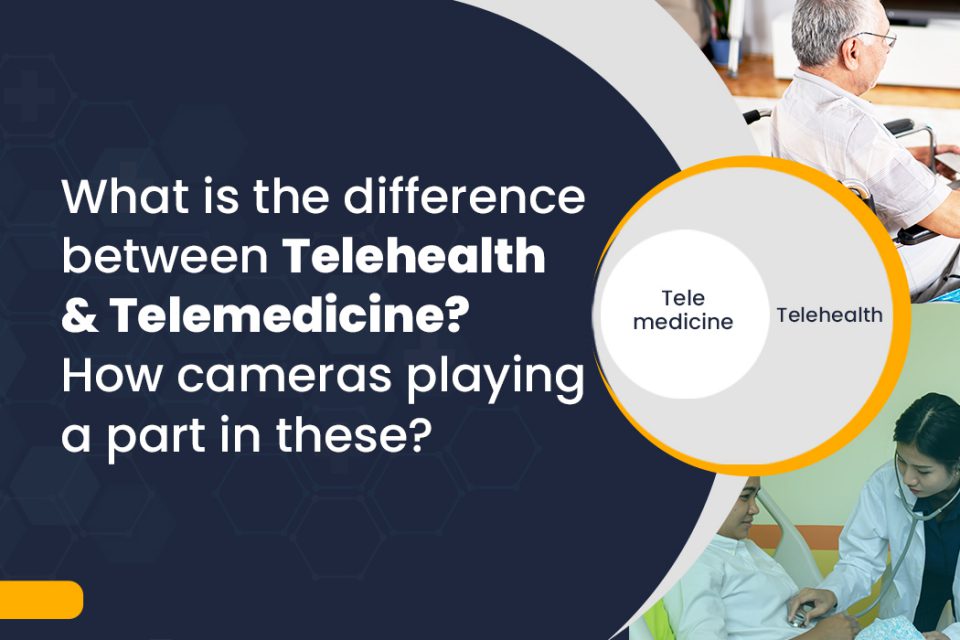With breakthroughs in digital healthcare technologies such as artificial intelligence, VR/AR, and robotics, the future of healthcare is taking shape right in front of our eyes. However, we are still battling to make ordinary people, besides healthcare workers, aware of these technologies and their terminologies.
It’s why many are still unable to tell the difference between telehealth and telemedicine. While the debate over these terms is far from over, it’s important to know what each of them represents before understanding what makes them unique. In this article, we attempt to find out the real difference between telehealth and telemedicine. We will also look at the role of embedded vision and cameras in these two.
What is telemedicine?
Telemedicine involves the technology enablement of medical professionals to remotely diagnose and treat patients. In addition, by using devices like computers and mobiles, they can provide clinical or consulting services without the need for in-person visits.
Some of the activities carried out by means of telemedicine devices and techniques are ensuring follow-up visits, chronic disease management, and medication management.
Telemedicine has become a bigger deal off-late due to the need for contactless healthcare experiences in a pandemic-influenced world. For instance, especially in this age where even something as common as cold is seen with trepidation, enabling remote diagnosis and treatment for doctors and medical professionals is of utmost importance.
Another example for telemedicine would be to help understand the imaging results of an MRI scan taken from a hospital that doesn’t have an on-call radiologist.
What is telehealth?
As far as telehealth is concerned, it involves health or health-related services being provided to medical professionals to share data and interact with patients via digital technologies. While it covers some of the aspects of telemedicine, telehealth is much broader and also covers non-clinical services that allow clinicians, specialists, and lab technicians to communicate with each other to create seamless healthcare journeys.
A few areas covered by telehealth are virtual supervisions, patient monitoring, digital awareness programs, and contactless patient onboarding.
Once again, the impact of the pandemic has led to a surge in the adoption of telehealth, especially in the case of data sharing, which has proved to be invaluable to get an integrated look at the patient’s health without relying on multiple physical touchpoints. For example, tele-ultrasound has been tremendously useful – allowing collaboration between sonographers and medical specialists through a virtual platform.
Telehealth has also made it easy to monitor at-risk patients with cardiovascular problems. It offers real-time sharing of patient information to doctors and clinicians to continuously assess the patient’s condition and modify the treatment if there’s a need for a change.
Demystifying the debate: telehealth vs. telemedicine
As earlier addressed, there’s a lot of confusion between the distinguishing features of telemedicine and telehealth. One way to navigate past the complexities of these terms is to understand that telehealth covers what telemedicine does not. The former only gives access to remote clinical services, whereas the latter also offers non-clinical services.
Furthermore, telehealth differs from telemedicine by focusing on creating superior healthcare operations by enabling staff training, administrative discussions, and ongoing education and awareness.
Hence, it would be fair to conclude that telehealth leverages a broader range of digital technologies to enhance patient diagnosis, treatment, and care and deliver unified and proactive healthcare journeys.
How do cameras play an important role in telemedicine and telehealth?
It’s no surprise that cameras play a pivotal role in creating a digital gateway to deliver telehealth experiences. Now, let’s look at how cameras are used to deploy, secure, and improve critical aspects of telehealth.
With the need for remote diagnosis, treatment, and post-treatment on the rise in today’s healthcare climate, the type of camera has a huge role in determining the effectiveness of a telehealth device. It also impacts medical research, which has gone remote for the past two years. However, there are no one-size-fits-all cameras suitable for telehealth, in general.
Selecting the right camera for telehealth devices
The camera selection process primarily depends on the use case of the device. Sometimes, it doesn’t take much to deliver telehealth experiences! For example, follow-up consultations and therapy sessions only require a laptop or a smartphone camera. They help provide clear images that allow doctors to assess and diagnose patients virtually.
At the same time, certain other applications need more advanced embedded vision cameras to deliver the required results. This could involve inspecting a patient’s mouth, assessing a wound’s condition, analyzing skin texture and condition etc.
Following are some of the most critical features you need to consider while choosing an embedded camera for a telehealth device.
- High resolution
- Inbuilt microphone
- Low-light and IR (InfraRed) performance
- High Dynamic Range (HDR)
- Pan/tilt and digital zoom
- Low-power consumption
- Small form-factor
Major camera based use case in telehealth: Remote Patient Monitoring (RPM)
Though there are numerous camera based applications in telehealth, the most popular of them is RPM or remote patient monitoring. RPM requires one or more cameras to be installed in every patient room in hospitals to monitor the patient on a 24X7 basis. But these cameras are not a part of the hospital’s security system. Rather, they are linked to patient biotelemetry devices and monitored by a team of paramedics from a centralized location.
The cameras should stream 24 hours a day and send quality output to the network where it is being monitored. When armed with a high-resolution 4K ultra-HD camera, the telehealth device can cover the entire room and patient’s bed to share clear images with medical professionals. The camera is also recommended to come with low light and NIR (Near InfraRed) capabilities for reliable imaging in the night, especially during sleeping hours.
To learn more about how embedded vision plays a key role in transforming telehealth and remote care, have a look at the article Role of embedded vision in empowering post operative and at home patient care.
e-con Systems’ cameras for telehealth devices
e-con Systems has a proven track record of helping telehealth providers to build the perfect camera solution for their use cases – from enabling collaboration between clinicians and doctors to delivering superior patient care experiences.
Given below is the list of e-con cameras suitable for telehealth. It is to be noted that the camera choice will heavily depend upon the use case, and it is recommended to take the help of a camera expert while picking one.
- See3CAM_160: 16MP high resolution USB autofocus camera
- See3CAM_130: 4K autofocus USB camera
- See3CAM_CU135: 4K USB camera board
- e-CAM131_CUMI1335_MOD: 13MP 4K camera module
- e-CAM130_MI1335_MOD: 13MP autofocus camera module
- e-CAM160A_MI298_MOD: 16MP Sony IMX298 autofocus camera module
- e-CAM82_USB: Sony STARVIS IMX415 4K low light USB camera
- e-CAM83_CUMI415_MOD: Sony STARVIS IMX415 low light camera module
- See3CAM_CU135M: 4K monochrome USB3 camera
- See3CAM_CU81: 4K HDR USB camera
- See3CAM_CU55: 5MP low noise USB camera
- Conversa: Full HD low light USB camera with microphone
- See3CAM_CU30: 3.4 MP low light USB camera
Looking for help in choosing the right camera for your telehealth device?
Please write to us at camerasolutions@e-consystems.com.

Balaji is a camera expert with 18+ years of experience in embedded product design, camera solutions, and product development. In e-con Systems, he has built numerous camera solutions in the field of ophthalmology, laboratory equipment, dentistry, assistive technology, dermatology, and more. He has played an integral part in helping many customers build their products by integrating the right vision technology into them.


